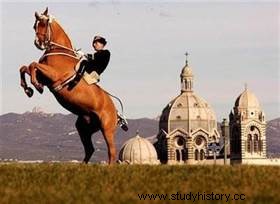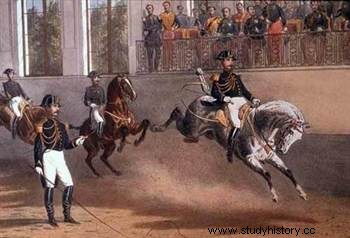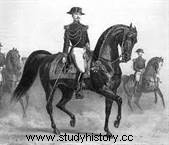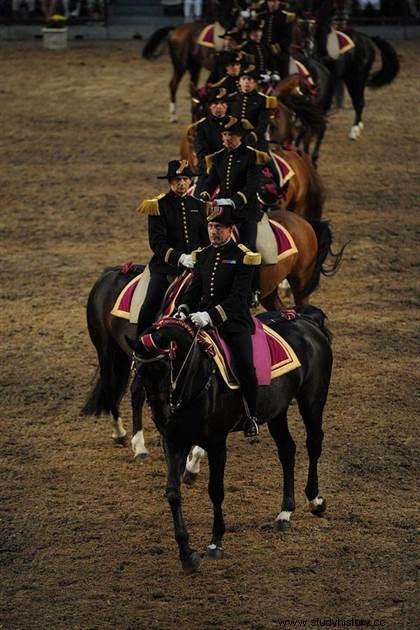 Founded in 1764, the prestigious Cadre Noir de Saumur perpetuates a French tradition of equestrian art. Originally an equestrian military academy, the school lost its primary vocation after the two world wars. Having become a civilian, she joined the French Institute for Horses and Riding. In 2011, Unesco consecrated the equestrian art of the Cadre Noir de Saumur by registering it as a cultural heritage of humanity.
Founded in 1764, the prestigious Cadre Noir de Saumur perpetuates a French tradition of equestrian art. Originally an equestrian military academy, the school lost its primary vocation after the two world wars. Having become a civilian, she joined the French Institute for Horses and Riding. In 2011, Unesco consecrated the equestrian art of the Cadre Noir de Saumur by registering it as a cultural heritage of humanity.
The origins of the Cadre Noir de Saumur
During the Renaissance, the refinement of the Italian princely courts was at its peak. The festivals, the dance, but also the use of the horse for the parade, and not only for hunting and the war, extend in the European courts. From the Italian masters, the French squires teach new techniques for riding and introduce horse ballets alongside dances and music. Versailles, the Tuileries and Saint-Germain then became prestigious riding schools serving in turn as models for all the courts of Europe.
When François Robichon de la Guérinière, a squire who taught at the Tuileries riding school, published his Ecole de cavalerie in 1731, the work became a classic of the genre.
Saumur School
 It was at the end of the 16th century that Henri IV sent Philippe Duplessis-Mornay to Saumur, in the Maine-et-Loire, to found a Protestant university there, including a riding academy. Later, when Louis XV entrusted the Duc de Choiseul with the reorganization of the royal cavalry in 1763, the School of Saumur welcomed and trained the officers in charge of training in the cavalry regiments. Linked to the history of monarchs and courts, both prestige and almost exclusive privilege of the nobility, high horse riding subsequently suffered the effects of the conspiracies and wars of the Empire. After the Napoleonic wars, the cavalry was decimated. An academy riding school was created in Saumur in 1814 next to the armory, and Charles X confirmed in 1825 the organization of the Royal Cavalry School of Saumur. The first Cadre Noir carousel took place in 1828 (a name that only became official in 1986).
It was at the end of the 16th century that Henri IV sent Philippe Duplessis-Mornay to Saumur, in the Maine-et-Loire, to found a Protestant university there, including a riding academy. Later, when Louis XV entrusted the Duc de Choiseul with the reorganization of the royal cavalry in 1763, the School of Saumur welcomed and trained the officers in charge of training in the cavalry regiments. Linked to the history of monarchs and courts, both prestige and almost exclusive privilege of the nobility, high horse riding subsequently suffered the effects of the conspiracies and wars of the Empire. After the Napoleonic wars, the cavalry was decimated. An academy riding school was created in Saumur in 1814 next to the armory, and Charles X confirmed in 1825 the organization of the Royal Cavalry School of Saumur. The first Cadre Noir carousel took place in 1828 (a name that only became official in 1986).
Clothed in black
 The instructors, dressed in black, are distinguished from the squires of the Military Cavalry School dressed in blue and are already wearing the merry-go-round hat called the “bicorne” or the “lampion”. When the School of Versailles, where young nobles were trained in their preparation for the profession, disappeared in 1830, that of Saumur became the sole repository of the French equestrian tradition.
The instructors, dressed in black, are distinguished from the squires of the Military Cavalry School dressed in blue and are already wearing the merry-go-round hat called the “bicorne” or the “lampion”. When the School of Versailles, where young nobles were trained in their preparation for the profession, disappeared in 1830, that of Saumur became the sole repository of the French equestrian tradition.
The impetus given by General l'Hotte, chief squire from 1864 to 1870, proved decisive for the prestige of the institution where the work of "low school" was practiced. - which exercises the horse in its natural gaits to bring it to the highest degree of regularity - and that of "high school" - which allows to control collection and impulsion and to give the gaits a stylized form. Squires must master "school jumps" and "uplifted airs". Among these, the bow (the horse stands up to the sky with its front legs deployed), the croupade; (kick fully extending the hind limbs) and cabriole (almost simultaneous combination of a bow and a croup).
From military to civilian
 In the early 20th century, when tanks and aircraft gradually replaced horses on the battlefields, the question arises of the usefulness of the Cadre Noir within the army. The institution is also beginning to take an interest in the equestrian competitions of the Olympic Games, where its riders will gradually shine in each of the three disciplines:dressage, show jumping and eventing. The government cannot bring itself to make disappear what has become over time a real living heritage for France. In 1972, the Saumur Riding School, bringing together civilians and soldiers and dependent on the Ministry of Youth and Sports, was created by decree. The Cadre Noir thus passes from military status to civilian status.
In the early 20th century, when tanks and aircraft gradually replaced horses on the battlefields, the question arises of the usefulness of the Cadre Noir within the army. The institution is also beginning to take an interest in the equestrian competitions of the Olympic Games, where its riders will gradually shine in each of the three disciplines:dressage, show jumping and eventing. The government cannot bring itself to make disappear what has become over time a real living heritage for France. In 1972, the Saumur Riding School, bringing together civilians and soldiers and dependent on the Ministry of Youth and Sports, was created by decree. The Cadre Noir thus passes from military status to civilian status.
Equestrian art
In 2011, Unesco listed traditional French riding and the Cadre Noir de Saumur as part of the intangible cultural heritage of humanity. A recognition that honors an equestrian art made of discretion, research and complicity between the rider and the horse with a particular concern for elegance; an art of riding established on a harmonious relationship between man and horse which excludes the use of physical force or psychological constraint in its education as in its conduct. The transmission of school jumps, which originally served to obtain from the war horse a perfect submission and a very great maneuverability, makes it possible to prove the value and the solidity of the horse, but also the excellence of the rider. The perfect match.
Bibliography
- A history of the riders of the Cadre Noir de Saumur, from their origins to the 21st century, by Jean-Pierre Tuloup. Editions Grandvaux, 2000.
- A History of French Horsemanship, by Guillaume Henry. Belin, 2014.
